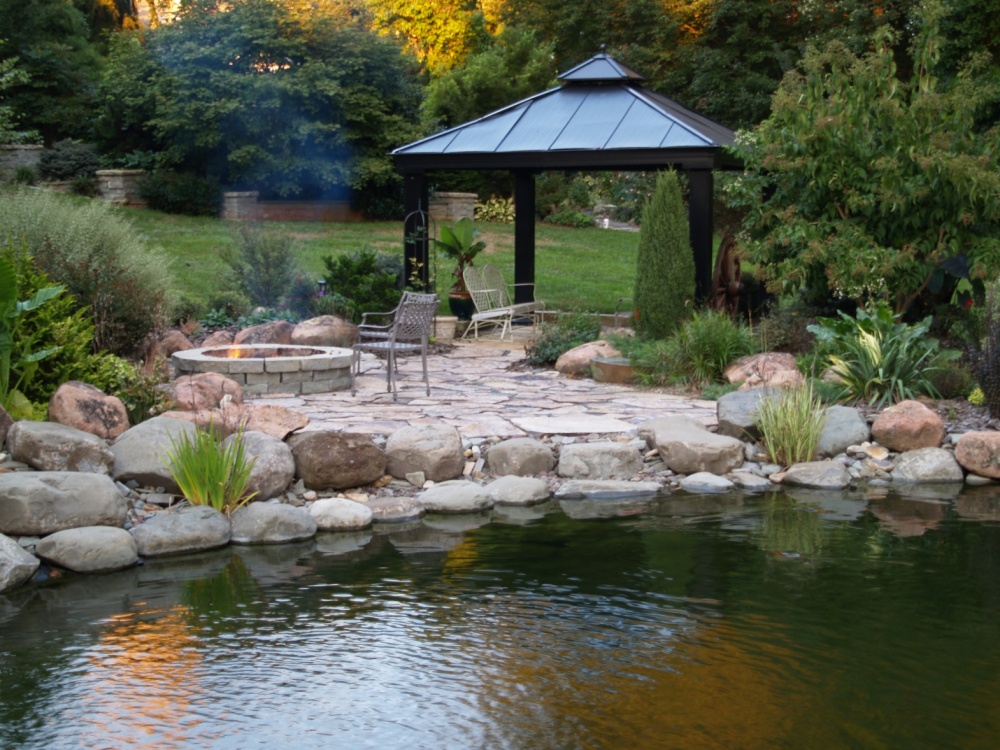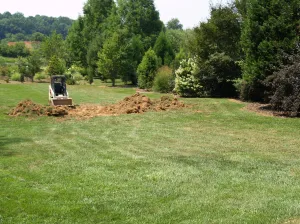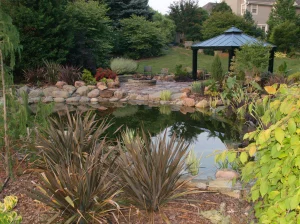 Just what I needed, another pond. The inspiration for my sixth and largest pond began with reading a garden magazine article about natural swimming ponds in Europe. A brief investigation on the internet revealed a couple companies in the US who had built one or two, and some reference materials. Within a few hours the idea became a design, then a material list, then an order for the liner and pump.
Just what I needed, another pond. The inspiration for my sixth and largest pond began with reading a garden magazine article about natural swimming ponds in Europe. A brief investigation on the internet revealed a couple companies in the US who had built one or two, and some reference materials. Within a few hours the idea became a design, then a material list, then an order for the liner and pump.
With my experience building ponds I made a number of modifications to the designs recommended by the European and American pond builders to simplify construction and maintenance. I didn’t intend to “swim” in the pond, but I wanted a large, deep pond so I could float with the koi. My priority in building this pond was the same as the other ponds in the garden, it had to be extremely low maintenance.
Construction
Construction began in early September 2006 digging the hole. Since the yard sloped to the back and side the excavation was used to fill on the lower side, so a portion of the pond is above grade. Most of the digging was done with the small skidloader shown in the photo, but at three and a half feet deep I encountered wet soil that made further digging with the machine impossible. So, the remaining loose soil and excavation was moved the old fashioned way, one shoveful at a time. My wife informed me that I was way too old to be doing this much labor, the first of many such warnings that I ignored.
I often try to dissuade potential do-it-yourselfers from undertaking major landscape projects because they can take weeks or months to complete, perhaps along with a trip to the emergency room. Our crews can often do the same work in a couple days. Even though the digging took two or three weekends and evenings after work, I was determined to do this project myself, like the rest of my landscape.
Once the hole was dug my son (our senior pond builder) helped me move the 50′ x 50′ pond liner, which weighed almost 800 pounds, into place. The liner went in just in time for it to start raining. The weather went from drought to monsoon season, and the pond began to quickly fill with water. While it was raining I covered the bottom with smooth tumbled rocks, then built the stacked wall that divides the pond from the filtration area. After the wall was built I laid P VC pipe on the bottom and filled the filtration area with bluestone gravel.
VC pipe on the bottom and filled the filtration area with bluestone gravel.
With the bottom of the pond covered and the filtration area complete I moved to building the waterfall and placing boulders. I was able to do most of the heavy work with a small machine, but much of the final placement was done manually. As the Fall season went on the weather got worse, so my workdays became fewer and further in between, but rain continued to fill the pond to the point that I thought that it was possible that nature would fill the 25,000 gallon pond for me.
The last foot of water to fill the pond was slow in coming, but warm weather came early this Spring, and I was anxious to get the pond running, so I ran the hose for most of a day to finish filling it. In late March 2007 the pond was complete.
The completed pond
Once the pond was complete I was ready to start floating. I was pleasantly surprised to find that the water warmed quickly in the shallow filtration area, so it warmed up much quicker than natural ponds. Within a couple weeks I introduced small koi to their new home, and bought a couple floating lounge chairs.
The next step was to landscape the area surrounding the pond. The first phase was a stone patio, firepit, and basic trees and shrubs. I also planted Japanese iris and acorus at the edge of the water, and a variegated leaf cattail in the gravel of the filtration area.
Over the next year I made many additions to the landscaping in the pond area. I added a gazebo with a travertine marble floor and many more plants. I’ve used a number of elephant ears and bananas to create a lush tropical garden late Spring through early Fall. 
What I’ve learned
There are many times in landscaping that a year later you wish that you’d have done something differently, but I wouldn’t change a thing about the pond. The areas where I’ve planted the tropicals allow me to dramatically change the look of the garden every year, and the pond has proven to take almost no maintenance. I’ve had to deal with some string algae, and I cover the pond with a large net in the Fall to keep leaves out, but it’s been less time than I would have taken to keep the grass mowed that was there before.
Since the average pond that Meadows Farms Landscape Department builds is less than 200 square feet, constructing a 1,500 square feet and 25,000 gallon pond has been a valuable experience. I’m confident that I’ve made good long term decisions on design and filtration, and the pump and materials I used to build it. We have built a couple ponds nearly this size recently, and have used my experience to make these ponds more efficient and beautiful.
I am so touched by the lovely way you have expressed yourself…. I see you as a true hortophile. Beautiful! Do you swim in your swimmin’ pond? I think I might need one.
I am very interested in desgning a swimming pond, very similar to what you describe above. I don’t see the link that you mention in your reply of March 16, 2009 to another poster. I have been doing quite a bit of research on swimming pond design, but there is not a lot of technical information available. E.g., smaller fish pond rules of thumb say that the flow rate must be half the pond’s volume. For a 25000 gallon volume, that’s 12500 gph, which is really huge, and is in contradiction with common statements that say that a natural pool needs a much smaller pump than a chemical pool. So it would be great if I could find out more about how you did it! Thanks!
I’m sorry that I haven’t a clue where that link went to, but the only reference that I used was at this site http://www.totalhabitat.com/p&p.html. I purchased the digital book, and found it helpful, though in the end I didn’t follow much of its guidance because I felt that the percentage of the pond that they were dedicating to filtration was more than was needed.
My pond is about 1500 square feet, and the filtration area (with water flowing up from perforated flexible PVC) is no more than 200 square feet. I have an 8000 gph pump that feeds about two-thirds of the flow to the waterfall (for aesthetics, but it aerates also) and a third to the filter. There is rounded river gravel on the bottom of the pond, and though I purchased a bottom drain the rains came and began to fill the pond before it was installed, so it sits in my garage.
I have never cleaned the pond, although I do cover it with a net in the fall to keep the majority of leaves out, and the water is clear enough to see the rocks on the bottom all through the year. Early in the spring I have had some issues with string algae, but after a dose of barley concentrate I spend less time maintaining this pond than the other four small ones (which is less than an hour per month, and none in most months).
It seemed from most research that I did that people tested their water regularly, but I would only tests for water quality if it turned cloudy, or if the fifty plus fish that live in the pond suddenly had some problems. I don’t believe that any of the sources I checked recommended fish in the pond, but it all seems to work.
If you have any other questions please let me know. By the way, the most recent photos of the swimming pond are on my most recent two posts.
Thanks a lot, Dave. I know about the Total Habitat e-book. I haven’t purchased it yet as I find $99 steep for a 40 page book which may not be so useful. But now that I’ve read your comments I will certainly reconsider. I have Michael Littlewood’s new book on order, which is supposed to be a building guide. If that still leaves me with questions I’ll go for the e-book. Your ratio of regen to swimming area is very uncommon, mostly I see a 50/50 recommendation, which is what I am thinking of. By doing that I hope to be able to avoid extra bio filters and UV. Fish are indeed mostly discouraged as they add more nutrients. So if you can keep a pool with fish and a low regen/swimming ratio clean enough with a reasonable small flow rate and no exrtra fitration or UV, then I should be in good shape!
Your pond pictures in your recent posts look great! Thanks again!
Many of the swimming ponds that you read about are public, so there is neccesarily more precaution about water quality. I figure that people have been swimming in natural ponds forever, so what could it hurt. At some point I will decide that there are too many fish, and I’ll move some to the smaller ponds.
Hello, I am writing a book on natural landscaping (more information is on my website) and I would love to include the photo of your pool in fall in my book. Would you be willing to contribute the photo? Please email me back and I could tell you who to send the photo to, and I would email you the release form.
Sincerely,
Beth Young
ps my deadline is very near.
I am attempting the same thing in the desert. Thanks for your inspiring post!